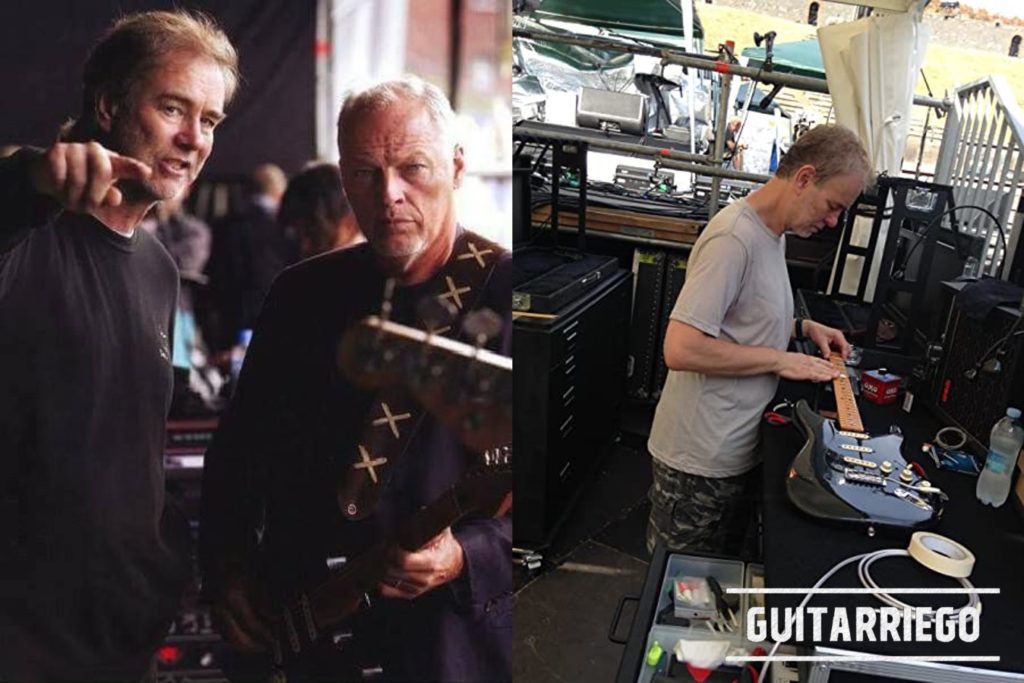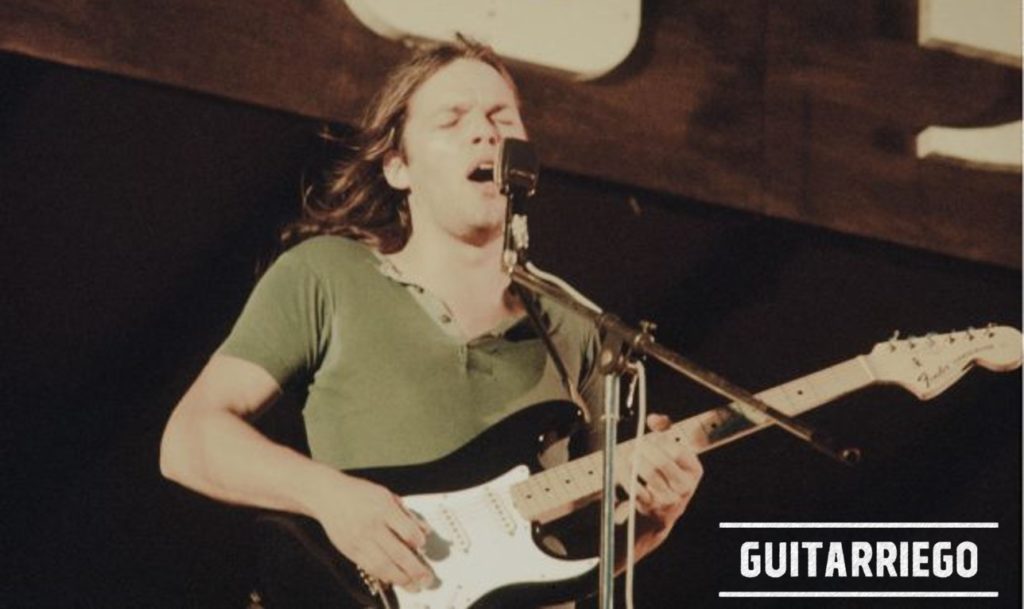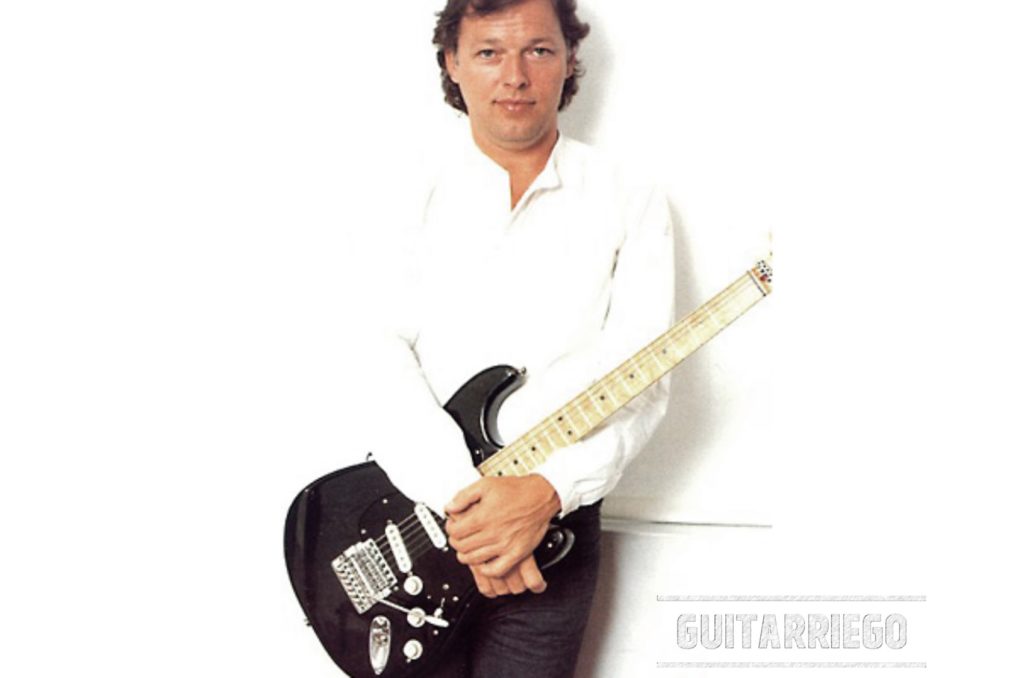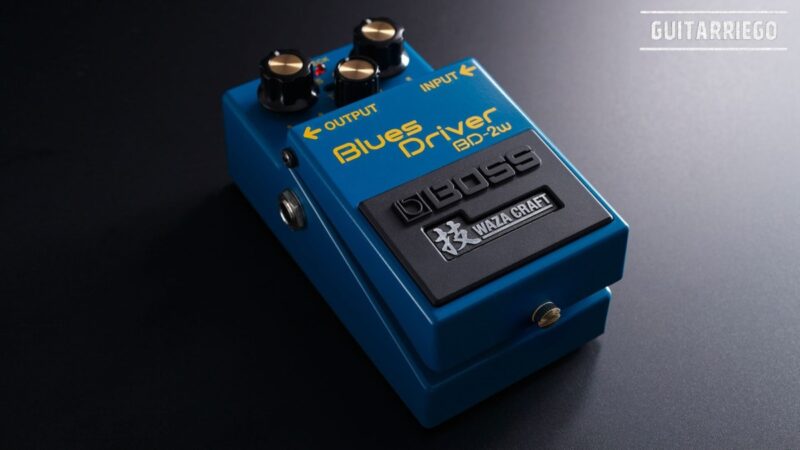David Gilmour’s Black Strat, and its incredible story

Black Strat is synonymous with one of the best guitars in rock history, by David Gilmour and Pink Floyd, but not everything was easy in the life of this iconic guitar.
The History of David Gilmour’s Black Strat
One would expect the history of this great guitar to be very special from the beginning. The perfect guitar that David chose from among several, such as Eric Clapton’s Blackie. However, the life of Gilmour’s Black Strat is not like that, considered as an ordinary guitar by the one who owned it for 45 years. In fact it is a Stratocaster Standard guitar from 1969, a year that is far from being considered the golden age of Fender.
This guitar, full of modifications, forgotten for a decade and rescued from exile, today holds the record for being the most expensive guitar in the world, when last year it sold for close to USD 4,000,000.
Interview with Phil Taylor, Pink Floyd manager
In March 2008, the British guitar magazine Guitar & Basses Magazine did an incredible interview with Phil Taylor, technician of Pink Floyd and David Gilmour, at that time, for more than thirty decades. In the report, Phil tells the story of David Gilmour’s Black Strat. Details of the “life” of this fascinating guitar that give you goose bumps. With good, bad and incredible moments, that one would never imagine.

The Black Strat, the story of an ordinary guitar
It’s just a Strat, a Fender Stratocaster Standard. It was made without any particular care, one more than those that were built in a factory. It did not come out of any Custom Shop where a luthier has invested hours, dedication and detail in building it.
It rolled off a production line along with thousands of other nearly identical guitars in 1969. A year that is not particularly recognized for being a great year. An ordinary factory instrument, nothing special, and as would be the case with many of the electric guitars played on in the 70’s, its owner was not concerned with its originality or vintage value.
Protagonism of the Black Strat throughout its history
Despite being a simple Strat, something different has this instrument. The Black Strat was used on the records Atom hesrt mother, Meddle, Obscured by clouds, Darkside of the moon, Wish you were here, Animals, The wall, as well as Live at Pompeii and in his solo projects by David Gilmour and About Face. . Until very recently it remained a working instrument. David Gilmour used it for the exciting Pink Floyd reunion on Live 8. It was also used in some of the main electric guitar parts from his recent work On an island. Finally, you can see and hear it on Gilmour’s splendid and incredible double DVD, Remember that night.

It was only in 2019, after the twists and turns of its mind-blowing history, that the Black Strat became a museum or collector’s item, when David Gilmour auctioned it off for charity.
David Gilmour’s Black Strat, the most expensive guitar in the world
In June 2019, Christie’s New York auction house auctioned the 126-guitar collection of Pink Floyd guitarist David Gilmour. In total, the sale of all musical instruments raised the amount of around USD 21,500,000, while the Black Strat was paid approximately USD 3,950,000. This not only made it the most valuable musical instrument sale ever, but also the most expensive guitar sale ever made.
Also the White Fender Stratocaster, used by David Gilmour regularly live and with which Another brick in the wall II and III was recorded, paid USD 1,800,000. The money raised by the musician went to the Client Earth charity, which fights against the effects of climate change in the world.
Fender Stratocaster “Black Strat” David Gilmour Signature Series Custom Shop
Of course, like every great iconic Fender, the Black Strat has its replica built by the brand’s Custom Shop. The price of one of these guitars is around SUD 5,500.

But let’s get on with her story told by the one who cared for her most of her life, Phil Taylor.
Phil Taylor, Black Strat Technician and Keeper
For more than four decades the Black Strat has been in the care of Pink Floyd manager and David Gilmour full time, Phil Taylor. Taylor was called to work with the band in 1974. Since that time, and countless times, he has rummaged through the Black Strat to not only make it work properly, but also radially shifted it to accommodate the changing needs of guitarist David Gilmour. Taylor, has reached the “Black Strat” in the best stages of the world.
Phil Taylor, author of David Gilmour’s Black Strat book
Phil Taylor, taking advantage of the fact that he knows the Black Strat as no one else in the world, even perhaps knows it as much as David Gilmour, wrote an exciting book on the history of this great guitar.
It tells the “life” of this Black Strat in much more detail than you can imagine and that we can dedicate to here, and contains enough information and rare photos of Pink Floyd to attract both fans of the band and fans of the black Stratocaster guitar.

Purchase of Gilmour’s Black Strat at Manny’s – 1970
It was 1970, when David Gilmour while in New York took advantage and went to the musical instrument store and bought the Black Strat, a standard model with a maple neck with a large headstock, characteristic of the time.
However, the Black Strat did not immediately become his number one guitar. But after spending time experimenting with others, including a brown Lewis Custom Telecaster with a maple neck, and a Les Paul Junior, he got down to business with it and it became his lead guitar in 1971.
It was a time when Pink Floyd was beginning to push the limits of what could be achieved in a live. When it came to technology they improvised on the fly and custom built both the sound and lighting systems to achieve results that could not be achieved with unmodified traditional or normal equipment, and the Black Strat had not yet suffered from the effects of the search for perfection in sound.

David Gilmour’s Black Strat modifications
The modifications that the Black Strat had were the most varied, from simple changes of pins or potentiometers, to more radical ones such as change of the neck. Below is the list of mods made on David Gilmour’s Stratocaster:
- XLR connection
- Pin switching and volume potentiometer
- Switch for the Gilmour Mod
- Neck was used for the Double Neck Stratocaster
- Change of neck for one with Rosewood fingerboard
- Gibson humbucker pickup setup
- Pickguard placement -black pickguard-
- Bridge pickup replacement for a DiMarzio FS-1
- New Jackson neck for the Black Strat
- New Seymour Duncan SSL-5 pickup
- 22-fret Jackson neck
- Kahler vibrato installation
- Reinstallation of original synchronized tremolo
- Fender Vintage Reissue 57 Neck Placement

XLR connection
Gilmour’s first modification was to put an edge-mounted XLR jack to send the signal to an external pedal and then go back to the guitar to allow the guitar’s volume control to be used. Not satisfied with the result, he removed it.
Pin switching and volume potentiometer
Other modifications followed, all the tuners were swapped for Schallers and a new volume potentiometer was tested to make it run smoother.
Switch for the Gilmour Mod
Gilmour then added a second switch so that he could add the neck pickup to the middle or bridge pickup. The modification is still there, but 1978, the slider was replaced by a mini toggle switch. “That gives a more Jazzmaster sound,” explains Taylor. “He doesn’t use it much, but it does work for him very well for certain parts.”
The neck was used for the Double Neck Stratocaster

Later, Gilmour began to struggle with the practicality of switching from normal guitar to slide guitar on stage. At Floyd’s performance, Live at Pompeii, he put the guitar on the floor and applied a steel bar to it. He came up with a brilliant solution: a double neck, one for normal playing and the other for slide. Gilmour sent a thick mahogany plank to English guitar maker Dick Knight, who made a huge strato-shaped body for two necks. The necks placed were the maple neck of the Black Strat and a neck with a fretboard or fingerboard of rosewood pre-CBS from 1963 from a Strat Sunburst that Steve Marriot had given him.
Change of neck for one with Rosewood fingerboard
“The double neck is generally not a very good idea,” says Taylor. “The guitar was very heavy and big, and it lasted very little time. But the important thing was that Gilmour found that he liked the feel of the rosewood neck better than the maple neck of the Black Strat. The solution was to change the neck of the Black Strat to the neck with a rosewood fingerboard. “

Gibson humbucker pickup setup
In 1973, David Gilmour had a Gibson humbucker placed in the bridge position, turning it into an HSS. It didn’t take David long to discover that he was a single-coil pickup guitarist.
“Gilmour has tried humbucker pickups a number of times, and he just couldn’t get along with that sound,” said Taylor.
Black pickguard: the birth of the all black Black Strat
The next modification to the guitar, in 1974, was aesthetic and consisted in the placement of a black pickguard. Fender didn’t make the black pickguard until 1977, so the new extra thick black pickguard was probably the brainchild of Dick Knight.
In that same year Phil Taylor joined the Pink Floyd team. Phil said, “I had seen them play so many times, and the Floyd’s were so far ahead of everyone else, that the fact that they asked me to work with them was incredible.” “The first thing I did was spend time working in a grimy little rehearsal room in King’s Cross, just the four of them and me. Two weeks later having written Shine on you crazy diamod plus two songs that later became known as Dogs and Sheep in Animals.”

Bridge pickup replacement for a DiMarzio FS-1
In 1977, the bridge pickup was replaced by one of the first possible alternatives, a DiMarzio FS-1. Which worked well throughout the Animals recording and tour, and also on his first solo LP called “David Gilmour” from 1978.
New Jackson Type 57 neck for the Black Strat
That same year the rosewood neck began to show signs of wear, so Taylor contacted Grover Jackson of the Charvel guitar parts company. Jackson made a 1957-style maple neck for the Black Strat, later a couple more sets for two of Rogers Waters’ three Fender Precision basses.
New Seymour Duncan SSL-5 pickup
The Black Strat finally found its bridge pickup in late 1979 (The Wall). “Seymour Duncan had sent David some pickups that had been custom wound,” says Phil. “It’s actually a unique model based on the SSL-1, which today is marketed as SSL-5, and it is still on the guitar today.”
22-fret Jackson neck switch
In 1982, Jackson made another neck, this time with 22 strings, to place it had to cut the pickguard a bit.
Vibrato Kahler: The Twilight of the Black Strat
David Gilmour decides to install a Kahler vibrato to the black Strat. “It seemed like a good idea at the time,” Taylor said. “But it turned off the sound of the guitar. It was one of the reasons he fell from grace. “

Reinstallation of original synchronized tremolo
After several years of disuse – see below the ‘Exile of the Black Strat’ – in the process of restoring the guitar, Taylor asked Charlie Chandler to remove the Kahler, fill the hole with wood and touch up the finished, and to reinstall the old vibrato-synchronized tremolo- original.
Fender Vintage Reissue 57 Neck Placement
Then, in the process of reclaiming the Black Strat, the Charvel / Jackson neck was replaced with one of the necks from the 1957 Fender Vintage Reissue guitars that Gilmour had purchased a few years earlier.
The exile of the Black Stratocaster
With the installation of the Kahler vibrato, the days of the Black Strat were numbered, as it turned off the sound of the guitar. In addition, that same time, 1984, Fender was recovering the quality of its guitars again, especially those of the Vintage Reissue series from 1957.

David and Phil went to Arbiter’s, north London, to test strat guitars. They played one after the other to test them without amplification. Among them were the 1957 Vintage Reissue guitars in Candy red and cream that became David Gilmour’s main guitars for the next twenty years. The Black Strat took a back seat. Phil stated: “The truth is that we forgot about her – the Black Strat-“.
A couple of years later, the Hard Rock Café asked David Gilmour for one of his guitars to display in one of their stores. The Black Strat was chosen, and thus shipped to Dallas, Texas. There, the Black Strat spent a decade behind glass. “But David was very clever,” said Taylor. “He didn’t give it to them; he told them they could borrow it if they made a contribution to a charity.”
The Return of the Black Strat by David Gilmour

Ten years later, Phil was going through some documents when he told David that maybe it was time to get the Black Strat back. Gilmour shrugged and said yes. Thus, Taylor contacted the Hard Rock Cafe, and to Phil’s surprise the response was that they were unaware of any loans; and they claimed that the Black Stratocaster was theirs. Phil immediately faxed them a copy of the original document, and the guitar was returned to them.
The restoration of the Black Stratocaster
David’s guitar arrived in a sorry state, after ten years in a shop window, some parts were missing. Impressed by the condition of the strat, Taylor began the mission to restore it. So it was that he asked Charlie Chandler to remove the Kahler vibrato, fill the hole with wood, fix the finish, and put back the original synchronized tremolo vibrato. The Jackson neck was replaced by one of the necks from the 1957 Fender Vintage Reissue. Thus, David Gilmour‘s Black Strat was back, and it sounded better than ever, although perhaps its time was past.

The Resurrection of the Black Strat
There was no guarantee that Gilmour would adopt the Black Strat again. He had gotten used to the 1957 Fender Vintage Reissue Stratocaster. These guitars had the addition of EMG pickups and external electronics, which were quieter and in a sense efficient. Phil Taylor got used to leaving the Black Strat out from time to time, ready to play, but David had little use for it, at least until 2003, when Eagle Rock / Isis did the TV show “Classic Albums” about how it was made. Dark Side Of The Moon. David was filmed with the Black Strat on Abbey Road. “He didn’t say anything about it, but at least he used it,” Taylor said.

Live 8: Pink Floyd reunites
Two years later Pink Floyd reunited for Live 8. Phil got a call from David saying they were going to do it with Rogers. “You are in command. Organize everything! “Said David.
Thus, Taylor began production. He had three weeks and two for rehearsals, no staff, no equipment, and no place to rehearse. “It was an incredible mix of excitement, adrenaline, fear and nerves.” Phil said. “It was about Pink Floyd, it didn’t have to be right, it had to be perfect!”
“In early rehearsals Gilmour played the red Strat with the EMG pickups. The second day was the same. But on the third day, he tried the Black Strat, and everything changed. It was real singlecoils again. The sound went on a totally different level. And it’s funny, but I noticed, and so did some of those who have been with the team for years, that when he hung it, his body language changed. It was very exciting to watch. “
Phil Taylor

The Pink Floyd Live 8 concert in Hyde Park, London, was the musical event of that decade for generations of Pink Floyd fans. “It was also very strange,” Taylor said thoughtfully.
“Suddenly, there was Pink Floyd with David, Richard, Nick and Roger, just for once, showing the world that they were still a great band, and there, once again, was the Black Strat.”
Thus, the Strat was one of the predominant guitars in the recording of “On An Island” and the lead guitar for the subsequent tour. After all those changes, after hanging on a wall for ten years.
David Gilmour’s vision of the Black Strat
Phil finally recounted David Gilmour’s reaction when he brought up the idea of writing a book about the mythical musical instrument: “But at the end of the day, it’s just a guitar. When I sat down to write the book, David’s reaction was to tell me it was a stupid idea, why write a book about an ordinary Strat that he bought almost forty years ago that Gilmour bought forty years ago at Manny’s in New York?
David Gilmour’s Black Strat, an ordinary but special Strat

“But back then it was a decent musical instrument; after all, he – David Gilmour – chose it. He has always been happy to make changes, and while some things haven’t worked, others have. We have always cared for her. But we have never treated her with many bows. It’s just a Strat, his working instrument, and that’s how he’s always seen it. “
For more information on the guitar, visit Fender web site.
Related Post: Eric Clapton’s Blackie: History of the Great Fender Stratocaster.
You can share opinions or also chat about this and more with other musicians in our comments section.






